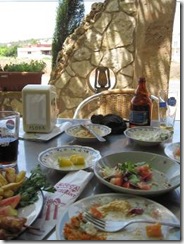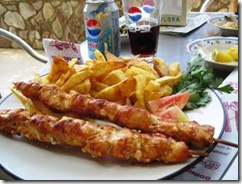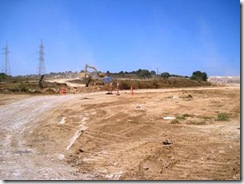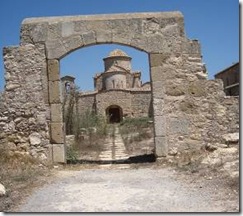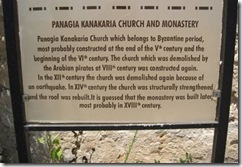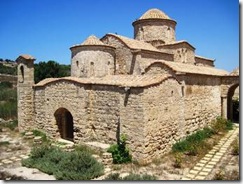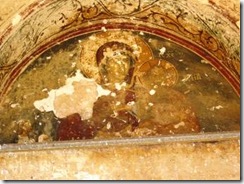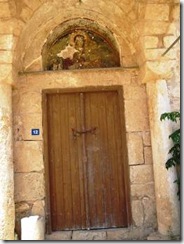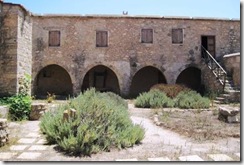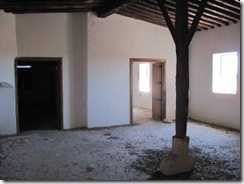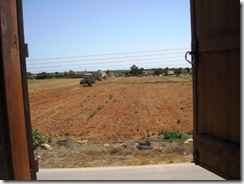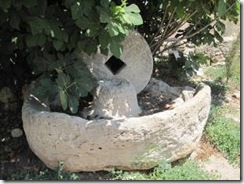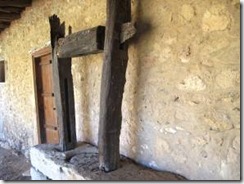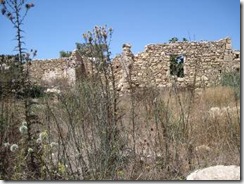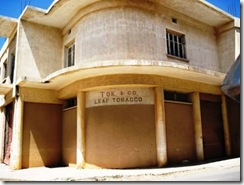Another story, another meal, another church……and a real art theft mystery!
Ru
ps lots of variations in the spelling of place names and some British spelling too…so I just cancel spell check and hope for the best.
Because no email from me would be complete without food photos!
We had a table full of food! Meze, bread and then we split this order of chicken kabobs.
I told a story previously about a British woman explaining she was staring at the food and not at us eating. This is the food. We were already full from the variety of meze when the chicken was brought to the table. Half the wonderful “chips” were still there when we left.
We really had no plan, or not one either of us remembers other than to go down new roads we’d never been on before. We ended up at the small town of Mehmetcik known for its production of olive oil and then we certainly ended up on a really “new road”…just paved, no signs, no markings and it just ended…
None of the construction crew said anything and the dirt eventually lead to an older road that took us by the Panagia Kanakaria Church just outside Boltashli.
Panayia Kanakar
“The main building is from the 6th century and there was once a beautiful mosaic of the Blessed Virgin and Christ child, flanked by the Archangels Michael and Gabriel, in the apse. Slowly over the years pieces of the tesserae ( mosaic tiles) were removed as it was believed they possessed miraculous powers to cure skin diseases. In the 20th century a large piece of stolen mosaic was found when an attempt was made to sell it on the open market. It was repatriated and is now in the Byzantine Museum in South Nicosia.
http://www.northcyprus.co.uk/panayia-kanakaria/
(There’s a great art theft story connected to this church…..)
The Church was locked but this partial work is visible over a side door.
The art theft story……..
“The church of Panaya Kanakaria was built in the 5th century, and the mosaics have been dated to the middle of the 6th century. Antiphonitis Monastery and its frescoes are a little younger, dating to the 7th century.
Around 730, the Byzantine emperor Leo III began the iconoclast campaign by ordering the removal of an image of Jesus prominently placed over the Chalke gate, the ceremonial entrance to the Great Palace of Constantinople, and its replacement with a cross. The purpose was to ensure that religious images would not become objects of veneration. This edict was repeated throughout the empire, resulting in the almost total destruction of religious icons and frescoes. However, some images in churches at the edge of the empire slipped through the net. The Kanakaria mosaics and the frescoes at Antiphonitis monastery were included in this group, and are recognized as being among the most significant surviving images from the Byzantine period.
In 1974, Turkey occupied the northern part of Cyprus, including the Karpaz village of Lythrangomi (now known as Boltasli). The Greek Cypriots of the area remained, not leaving till 1976. At that time the mosaics were still intact, as the villagers hoped to return after a short period away.
In 1979, two foreign visitors to the church reported to the RoC (Republic of Cyprus, the south not the Turkish Republic of Cyprus, the north) Department of Antiquities that the mosaics had disappeared. Because of the difficulties visiting the area at the time, this report was not confirmed till the middle of 1980. On the 30th July 1980, the Director of Antiquities contacted international authorities and museums notifying them of the theft, and in a letter to The Times published on the 9th August 1980, he asked to be contacted should anything appear on the market.
In the summer of 1988, Peg Goldberg, an art dealer from Carmel, Indiana, was in Europe shopping for work for her gallery. While there, she was approached by another art dealer, Robert Fitzgerald, and asked to consider the purchase of four early Christian mosaics. The mosaics, each about 2 ft square, consisted of an adolescent Christ, the Apostles Mathew and James, and an Archangel. Fitzgerald then arranged a meeting in Amsterdam on the 1st July with Michel van Rijn, a Dutch art dealer, and Ronald Faulk, a California lawyer who represented Fitzgerald and van Rijn.
Van Rijn was a colourful character, claiming to be descended from both Rembrandt and Rubens, and was a published expert on Christian icons. He had, however, also been convicted for art forgery.
At that first meeting on the 1st July, Goldberg was shown photos of the four icons. She was told that the seller was a Turkish archaeologist, Aydin Dikman, who had found the mosaics in an extinct church in North Cyprus, and that he had exported them to Munich with the permission of the TRNC (Turkish Republic of North Cyprus) government. She was told that the asking price was $3 million. Goldberg asked Faulk to let the buyer know she was interested. He immediately took this message to Dikman in Munich.
The following day, Faulk returned to Amsterdam, having agreed to buy the mosaics on behalf of van Rijn for $350,000. Goldberg, however, was not told of this deal. He showed her copies of the export documents for the mosaics, none of which was genuine.
On the 3rd July, the principals met in Amsterdam, and agreed to buy the mosaics for $1,080,000. They agreed to split the profits on any resale as follows. Goldberg 50%, Fitzgerald 22.5%, van Rijn 22.5%, and Faulk 5%. Goldberg now approached her bank and requested a loan of $1,200,000, the purchase price plus an amount to cover expenses, insurance, and restoration. As security for the loan, she showed the bank three appraisals valuing the mosaics at between $3 and $6 million.
On the 5th July Goldberg and Fitzgerald went to Geneva for the transfer of the Mosaics. Faulk and Dikman arrived from Munich, and arranged for the transfer to take place as soon as the money was in Goldberg’s bank account, which would take a couple of days. During this time, Goldberg claimed she made efforts to ensure that the mosaics had not been reported stolen. It is significant; however, that Goldberg did not contact the TRNC, the RoC, Interpol, or any Byzantine art experts.
Two days later, the money arrived, and Goldberg handed over $1,080,000 in return for the mosaics. Faulk, Fitzgerald and van Rijn then paid Dikman the agreed $350,000 and split the remainder of the money among themselves. Goldberg returned to Indiana on the 8th July.
Soon after, Peg Goldberg decided to profit from her purchase of the mosaics by selling them, with an asking price of $20,000,000. One of the museums approached was the Getty museum in California, where the curator, Marion True, had suspicions about their origin. She contacted the RoC who confirmed that they were stolen property which they would like returned. After this request was refused by Goldberg, the RoC, jointly with the Church of Cyprus commenced legal proceedings for their return.
The trial began on the 31st May 1989, with Peg Goldberg losing both that and the subsequent appeal, and the mosaics were ordered to be returned to Cyprus, without any compensation to be paid to Goldberg. The court ruled that she had not shown "due diligence" in establishing the mosaics’ provenance. On the 30th August 1991, the mosaics finally arrived back in Cyprus, and after a period of renovation are now housed in the Byzantine museum in Nicosia.
The two main characters in this story now disappear for a number of years. However in February 1997, van Rijn, apparently having fallen out with Dikman, and tired of a life of crime, approached (or was approached by, the details are unclear, Tasoula Hadjitofi-Georgiou, the honorary consul of Cyprus in the Hague. He offered to help in buying back three Kanakaria mosaics and 44 frescoes, asking for protection for himself and his family. He said it would be too dangerous to try to trick the objects from their present owners, but thought he might be able to buy them. Asking only expenses for himself, and with the blessing of the RoC government, around £300,000 of private funding was made available for the operation. To show good faith, on the 5th September, van Rijn delivered the mosaic of Thaddeus to the Hague.
The following day, van Rijn flew to Munich, buying 25 frescoes from Dikman. They were flown immediately to Rotterdam, where experts confirmed that the frescoes included the Tree of Jesse and the Last Judgement, missing from Antiphonitis church since 1976.
On the 7th September, van Rijn returned to Munich and negotiated the purchase of seven larger, less damaged, frescoes. On the 18th September, Hajitofi-Georgiou insisted that the police be called in.
An element of farce now enters the story. Fearing for his own freedom, van Rijn fled to Bangkok. Persuaded to return, he accompanied two Interpol officers to Munich to take part in a "sting" to retrieve the art work. However that evening, in attempting to leave his shoes outside his hotel room for cleaning, he found that his door was jammed. Convinced he had been locked in his room prior to being arrested, he fled once again, this time to Curacao.
The misunderstanding was eventually resolved, and on being given immunity from prosecution, on the 9th October van Rijn and thirty police officers took over an entire floor of the Munich Park Hilton Hotel. The following night, Dikman was arrested as he handed over the objects. A search of Dikman’s home later retrieved 14 cases and packages in which were icons, two Antiphonitis frescoes, and the mosaic of St Thomas form Kanakaria. A search of another property found 20 more boxes and cases with icons, more frescoes from Antiphonitis, early bibles, ancient pottery, statues and coins, as well as $100,000 in cash. The total value amounting to $40,000,000.
In November 1997, police discovered a third apartment rented by Dikman under a false name. In the cellar they found another 30 crates with 130 icons, 25 frescoes, two mosaics, other artefacts, and an unauthenticated Picasso.
Although Cyprus applied for Dikman’s extradition to stand trial in the RoC, this was refused by the German authorities. Some of the artifacts were returned to the island in July 2004. However, the identity and ownership of many of the others were hotly disputed. The RoC had to prove that the artifacts had come from the specific churches listed, and that they were there at the time of the Turkish intervention.
In a bizarre twist, Dikman never had his day in the criminal court. Some of the crimes he was accused of were found to be outside the statute of limitation. And the main prosecution witness, van Rijn, refused to testify. On the 13th January, 1999, he held a press conference claiming he had been asked by the Greek Cypriot authorities to organize the theft and smuggling abroad of antiquities from Northern Cyprus. The smuggled items were subsequently purchased and returned to the Greek Cypriot church with large scale press coverage. He further claimed that some antiquities were smuggled from southern Cyprus with the full knowledge of the director of the antiquities department of the Greek Cypriot administration. These items were also purchased back, and among great publicity blaming Turkey, were returned to the Greek Cypriot Orthodox Church. He said that he now realized that the aim of the Greek Cypriot authorities was anti-Turkish propaganda.
Because of the continued failure of the criminal case, in 2004 the Church of Cyprus decided to bring a civil case against Dikman. This trial started in April 2009, and on the 23rd September 2010 the court decided that the Church had proven the provenance of the artifacts, ordering their return to Cyprus.
Where are they now?
Van Rijn made his peace with the RoC regarding payment of expenses. It’s not known if he withdrew his allegations. He continues to act with the authorities in retrieving stolen works of art. This has made him many enemies and has caused his website (now closed) to be removed from Google.
Dikman is still in Germany, trying to prove that he had legitimate title to all the works of art he had in his possession or sold in the past. Although the German statute of Limitations won his criminal case for him, he is considering an appeal against the civil judgments.
Peg Goldberg moved her gallery to Florida. She specializes in 20th century art, and is a well respected expert in the subject. Her escapade with the Kanakaria Mosaics was her only foray into Byzantine art.
Marion True, the curator of the Getty Museum, is no longer there. In October 2005 she resigned her position. Later that year she was prosecuted in Italy for dealing in stolen works of art. She was accused of illegally obtaining 42 items during the 1980s and 1990s, including a 2,000-year-old 5ft statue of Apollo unearthed in Italy. The charges against her were dismissed on a technicality. In April 2006 at least a dozen antiquities were found during a police raid on her holiday home on the Aegean island of Paros. She was tried in Athens 2007 for illegal possession of artifacts, with the same outcome as the Italian trial.
http://www.whatson-northcyprus.com/interest/dipkarpaz/kanakaria/mosaics.htm
The New Yorker Magazine also ran a story about the art thefts….
THE ANGEL ON HER SHOULDER- by Dan Hofstadter
July 13, 1992
(This is an abstract: check with your local library for the full article.)
Antiquities; Art Dealers; Art-Thefts; Cyprus; Fitzgerald, Bob; Goldberg, Peg; Greek Orthodox Church ABSTRACT: ANNALS OF THE ANTIQUITIES TRADE about the theft and sale of Byzantine mosaics from the church of Panagia Kanakaria, in Lythrankomi, Cyprus. Four years ago, Peg Goldberg, a fledgling Indianapolis art dealer, bought four of the mosaics from a man posing as Aydin Dikmen, a Turkish businessman. She paid three million dollars, borrowed from Merchants National Bank, of Indiana. She became involved in the deal through her then friend, Bob Fitzgerald, a former exotic-animals dealer turned art smuggler. He convinced her to go to Amsterdam to buy a reputed Modigliani nude from a dealer named Jack Vecht. The painting turned out to be an obvious forgery. But Bob then introduced her to his friend Michel van Rijn, saying he was a dealer specializing in East Christian art. Michel showed her photos of the four mosaics. Along with a lawyer named Ronald Faulk, the men arranged for Peg to see the mosaics and meet a man posing as Dikmen in Geneva. She got her banker friend Nick Frenzel to finance the purchase. She bought a St. Matthew, a St. James, an Archangel, and an adolescent Christ. She didn’t know that the murals were stolen from the church during the Turkish seizure of northern Cyprus during ’74. After hearing of the sale, the Autocephalous Greek Orthodox Church of Cyprus, through the agency of the Republic of Cyprus and that country’s U.S. lawyers, sued Peg in Indianapolis court. Tells about the trial. Peg was represented by Joe Emerson, Cyprus by Thomas Kline. Peg lost. Tells how she later met the real Dikmen.
The ancillary buildings that would have been used as workshops, storehouses, and quarters for the monks have undergone recent restoration but are not usually open to the public, in fact overall, opening hours tend to be somewhat sporadic. However it is well worth the detour open or not.
http://www.northcyprus.co.uk/panayia-kanakaria/
This ancillary building (but not the church) was open and I went wandering through.
The view from the top floor.
A stone grinder for grain… A press for either olives or grapes.
It pays to travel with a country boy, Randal guessed what both of these implements were used for though we don’t know their age, ancient or replicas….
Stone building just next to the church.
has a good bit of information about Kanakaria and pictures of some of the missing mosaics.
It’s fascinating just coming upon these ancient buildings so I don’t get tired of them the way I do museums. Just getting to wander around is quite nice though if an expert had dropped from the sky to open the church and give a tour, that would have been great.
And then there are the empty tobacco buildings….. so I started researching the Cyprus tobacco industry.
An empty tobacco building in Yeni Erenkoy
“In Turkish, the word Yeni means new, so this village is New Erenkoy. Once the centre of the thriving and lucrative tobacco industry, it has been administered since 1974 by Turkish Cypriots from Erenkoy (Kokkina) the village far out on the west coast of Cyprus, that appears on maps as a small enclave shut off from the remainder of North Cyprus.
After partition the tobacco conglomerates left the island and the industry was finished. However still very evident are the factories, packing houses and smokeries once associated with the business. Started during the middle ages with most tobacco being produced in the Larnaca area, in the 20th C production moved to the Karpaz and The Tobacco Cooperative Society built the vast warehouse close to the village. Within the last decade the industry has undergone a revival and tobacco can once again be seen growing in the Karpaz landscape.”
http://www.northcyprus.co.uk/yeni-erenkoy/
“The southern side, (of the Karpaz Peninsula) that includes most of the villages, has been the centre of the once thriving and lucrative tobacco activity in Cyprus. The industry stopped operations in 2004 and currently only the sale of tobacco stocks occurs. Agriculture is mostly a subsistence activity; farmers lack alternative incomes, and mostly are sheep and goat breeders.” LOCAL DEVELOPMENT STRATEGY FOR THE KARPAZ AREA Lefkoşa, 14 December 2010
Karpaz Tobacco Cooperative has been unable to sell its crop this year; EU accession could easily be
an opportunity for this cooperative in selling its crops to the EU market).
Doğuş Üniversitesi Dergisi, 2002, (6), 111-123
IMPACTS OF CYPRUS’ EUROPEAN UNION INTEGRATION
ON TURKISH CYPRIOT COOPERATIVES WITH EMPHASIS
ON THE FINANCIAL SECTOR OF COOPERATIVES
http://www.setav.org/ups/dosya/17226.pdf
And for pipe smokers…this is kind of interesting about the Cypriot Latakia leaf which is often mixed with Virginia tobacco.
http://www.glpease.com/Articles/Latakia.html Cypriot Latakia leaf
I have a BA in History from U Mass and an MLS in Library Science from Florida State. For 26 years they helped me earn a living. Now I’m having way more fun. No tests, no grades, just the pleasure of trying to answer my own questions. Just because I saw an empty tobacco building or an old stone church.

